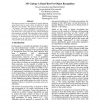Free Online Productivity Tools
i2Speak
i2Symbol
i2OCR
iTex2Img
iWeb2Print
iWeb2Shot
i2Type
iPdf2Split
iPdf2Merge
i2Bopomofo
i2Arabic
i2Style
i2Image
i2PDF
iLatex2Rtf
Sci2ools
ICRA
1999
IEEE
1999
IEEE
3-D Cueing: A Data Filter for Object Recognition
This paper presents a novel method for quickly filtering range data points to make object recognition in large 3D data sets feasible. The general approach, called "3D cueing," uses shape signatures from object models as the basis for a fast, probabilistic classification system which rates scene points in terms of their likelihood of belonging to a model. This algorithm, which could be used as a front-end for any traditional 3D matching technique, is demonstrated using several models and cluttered scenes in which the model occupies between 1% and 50% of the data points.
| Added | 03 Aug 2010 |
| Updated | 03 Aug 2010 |
| Type | Conference |
| Year | 1999 |
| Where | ICRA |
| Authors | Owen T. Carmichael, Martial Hebert |
Comments (0)

